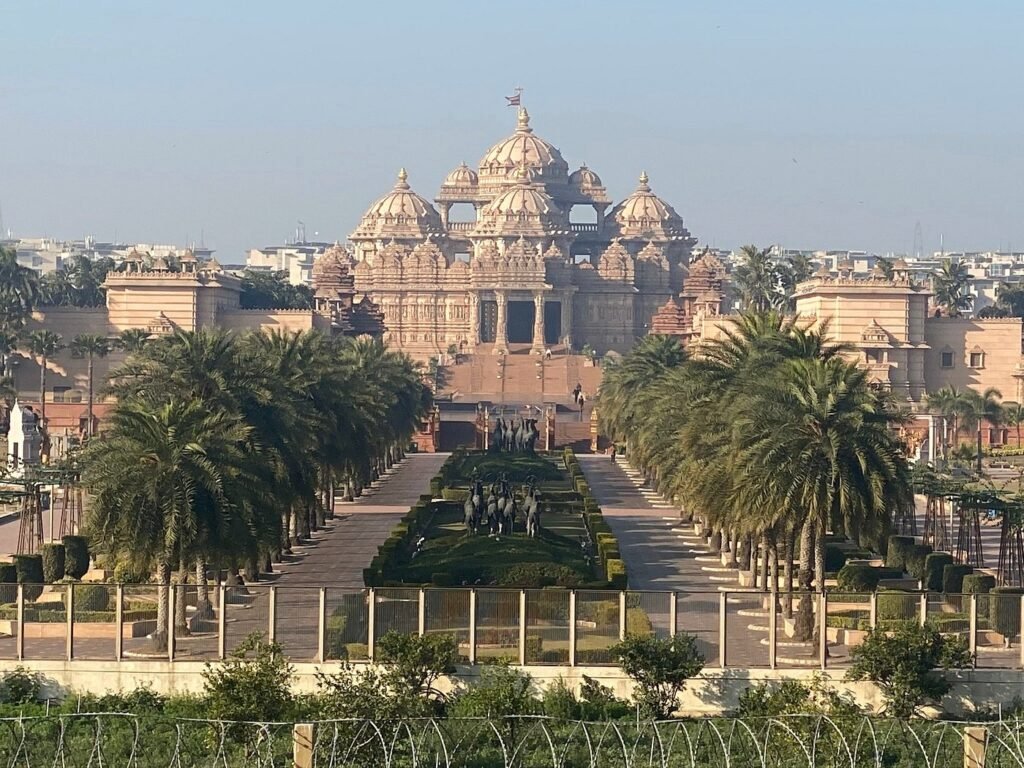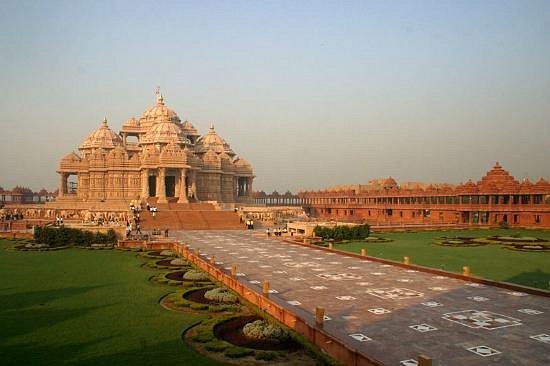Although Akshardham is far more than a temple, Akshardham defines the harmony of the symphony in spirituality, culture, and architectural excellence-all mingled together. Lying right in the middle of India’s capital, New Delhi, Akshardham soon found its place as one of the key points visited by a tourist coming into the country. The mega structure also is believed to be a spiritual hub for modern India comprising huge knowledge about the ideals, customs, and artistic brilliance of Indian culture. In the paper, we would describe Akshardham from different viewpoints-from its conceptual days to present times .
Akshardham: History
Indeed, the concept of Akshardham must be credited to the vision of Yogiji Maharaj, the fourth spiritual successor of Swaminarayan, to build such a monument where one can feel his or her bonding with one’s spiritual roots more needed in an urban bustle. It fell upon his disciple Pramukh Swami Maharaj to envisage this dream entrusted to him for building and constructing Akshardham by mobilizing thousands of craftsmen and volunteers into what was to become a modern marvel.
Akshardham was built in a record five years and was opened to the public in 2005. Among the values that people have in constructing this structure, some are: dedication, skill, religious passion; it is an indication, in general, that the Temple complex is one of the honors paid to Bhagwan Swaminarayan and reflects values and teachings which are part of the Swaminarayan tradition. Apart from being a huge religious site, by historic significance is meant another cultural beacon of the best in Indian art and architecture along with its spiritual vibration.
Structural Marvel
Design and Architecture
Akshardham represents the influence of many periods and regions. It thus represents a blend of the two old Indian architectural treatises also called Vastu Shastra and Pancharatra Shastra. A sprawling complex consisting of a grand central shrine, intricately carved pillars, spacious courtyards, and beautiful gardens is accommodated on more than 100 acres.
Traditional Architectural Styles of India Used
Akshardham represents ancient Indian architecture chiseled in the form of a myriad of carvings, domes, spires, and mandapas or pillared halls. More than 20,000 different statutes of gods, saints, and mythical creatures have been executed specifically on the temple façade. Indeed, such has the minute detailing gone into making each of these that volumes about the skill of the artisans who labored relentlessly to give shape to this grand vision.
In the whole temple, steel has not been used at any place. Each stone has been finely carved and interlocked to ensure the long life of this structure .
Main Temple
Central Shrine
The Akshardham presiding deity is that of Bhagwan Swaminarayan seated at the base in a yogic posture. In its lower section, Bhagwan Swaminarayan immovable Supreme Mandir has a lotus seat carved within his feet. At either side of him are the marble idols with gold and jewels overlaid of other revered persons in the Swaminarayan tradition, demarcating the sanctum sanctorum. In this process, the atmosphere inside gets charged with peace and divinity, wherein visitors and devotees plunge into deep reverential silence.
Excluding Bhagwan Swaminarayan, the other major Hindu gods worshipped in the main temple are Lord Krishna, Lord Rama, Sita, and Hanuman-all made of differently carved idols. The architecture of the temple is such that the aggregate of devotees at any instant of time are able to offer prayers seeking blessings from all those godly entities.

Importance of the Main Temple
The main Akshardham Temple is thus a spiritual abode whereby believers rediscover themselves and their relationship with the mighty Lord. This is the temple that has always borne eternal values of faith, devotion, and righteous living and inspired ideals from Swaminarayan tradition. It is thus not a temple but an institution of learning; it has within it a unique blend of different teachings and philosophies that have inspired Indian culture through the ages.
Structure in and around
Yagnapurush Kund
One of the imposing structures in the Akshardham complex which one can see is the Yagnapurush Kund. It is supposed to be the largest step well in the world. The sheer mass of water is architectural wonder for its beauty but for its spirituality too. It is lotus-shaped with 108 small shrines inside it given to various gods and goddesses. It, therefore, invokes the traditional Indian policy concerning the conservation of water and its view on the sacredness of the same in the Hindu way of life.
Sahaj Anand Water Show
Sahaj Anand Water Show Yagnapurush Kund is a mysterious spot and relates to the Sahaj Anand Water Show. An attempt at staging the fable of Nachiketa, a small boy who is prepared to raise questions from the lord of death Yama about the meaning and death. Now that juncture is getting materialized with the help of the latest technology. Combining the water fountains with laser light and fire, combined with musical art has now become mind-blowing and engraved scene into the viewers’ minds.
Thematic Gardens
Garden of India Bharat Upavan
The beautiful Garden of India Bharat Upavan in the Akshardham complex is basically dedicated to the rich cultural heritage of the country. All over the garden are strewn life-like bronze statues of the greatest leaders, saints, and philosophers of India- whatever has contributed to the annals of the nation in their respective ways. It is a place for contemplation where one can take a walk around the flora that surrounds it and draws inspiration from the lives of such great personas.
Yogihriday Kamal
It is in the shape of a lotus-shaped garden, with the inscriptions of Sutas by Yogiji Maharaj and other Gurus on every petal. This is symbolic of the unfolding wisdom of spiritual enlightenment where one may retire to meditate and reflect upon one’s life for more meaning.
Spiritual Significance
Akshardham represents a series of the world’s great wonders, which are actually abodes of eternal spirituality, leading all those who come from the universe over and full of peace. Devotees by millions come from the whole world to feel this energy and take part in lessons by Bhagwan Swaminarayan. The temple points to two aspects: compassion, humility, and devotion-that remind one that he should live his life righteously at the service of others.
Cultural Impact
Impact on Indian Contemporary Culture
Since its very inauguration, Akshardham has reflected influence on modern Indian culture and revived interest in various traditional Indian arts and crafts. In fact, it has actually set off a new trend among the artists and artisans of the new generation. As a fact, this insistence upon indigenous Indian culture within the precincts of the temple has been responsible for renewed appreciation for classical music, dance, and literature.

Contribution to Art and Literature: Akshardham has surely contributed much to the aspects of art and literature in which lots of the artworks get their influence and referral. Many books describe minute details about intricate carvings, dynamic murals, and majestic architecture, including lots of documentaries and artworks. It is placed as an icon for artistic prowess in the country and is actually a reflection of the rich cultural heritage that abounds in the country.
International Recognition and Awards
It got international recognition in architecture and divinity as Akshardham. Its importance in India has been adapted by giving it puri-highly ranked awards. In the Guiness World Records list, Akshardham was also included in the list as the biggest Hindu temple in the world. It is among those projecting further as a wonder in the world for its feasibility and ecological preservation.
Akshardham Visitors’ Experience: Expectation during a Visit The visit to Akshardham could turn out to be one for great reward-a mix of spirituality, culture, and even entertainment. The visitors are taken through guided tours through which the different structures in the temple complex can be viewed. These tours depict the history, architecture, and spiritual essence of the various buildings constituting the complex. Boating, exhibitions, Sahaj Anand Water Show amongst others could be gone about by the tourist at this complex. Fundamentally, a lot can be done in a day. There is a food court serving traditional Indian cuisine within the complex, thus it would be a great destination where full-day excursions could be rightly planned.
Akshardham is different. One may avail guided tours in many variants and pick up the one which best fits his time and interest. Akshardham guided tours bring in history of the temple in terms of conceived architecture and cultural beliefs. Facilities w.r.t. parking, lockers and accessibility to wheel chairs make your visit comfortable on all counts .
Best Time to Visit
Akshardham falls between October and March because the temperature is decidedly much cooler, more pleasant, and ideal for most of the outdoor activities. Mornings and late afternoons are also an appropriately good time because they are the least crowded hence affording good opportunities to be with oneself in the temple.
Rules and Etiquette
Visitor Guidelines
These call for some basic code of rules and regulations as a visitor to maintain that sanctity of Akshardham: dressing modestly, taking off one’s shoes before going into the main shrine, not photographing inside the shrine. It also calls for the maintenance of near-silence and religious sentiments.
.
Cultural sensitivities
It is a place of great spiritual solace, and it has been advised that one respects cultural sensitivities while going on a tour of the place by showing regard for religious activities not touching or pointing towards the idols following the code of conduct of the temple .
Akshardham in the Modern World
Technological Works
Akshardham is traditional in design, but also takes this most recent use of technology combined with ancient wisdom.
That depicts that even the water body is designed by state-of-the-art technologies, so the area is very safe and interactive to visit for all people of all age groups.
Environmental sustainability
Akshardham has implemented practices like collection of rainwater, harnessing solar energy, and effective waste disposal. This reduces the ecological footprint; thus, it acts as a role model for the other establishments.
Community and Social Impact
Akshardham provides employments that allow the children to go to school or youths supporting other social causes. Outreach programmes in the temple upliftment of underprivileged sections of society and commitment to social obligation.
Conclusion
Akshardham monumental proclaims the spirit of spirituality, culture and architectural excellence right in the heart of New Delhi. Akshardham represents tradition and modernity in a way as would perhaps plunge every visitor deep down into the unfathomable ocean called heritage and its spirituality-whether he is a tourist or an aspirer of Truth. Whether Akshardham turns out to be a divine home for adherents and pilgrims, or a paradigm for cultural edification to any sightseer, it really does promise to engrave its indentation on your heart and soul forever.




